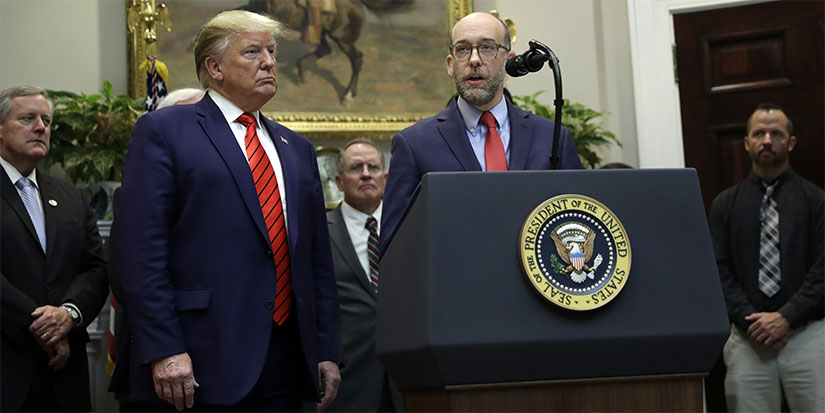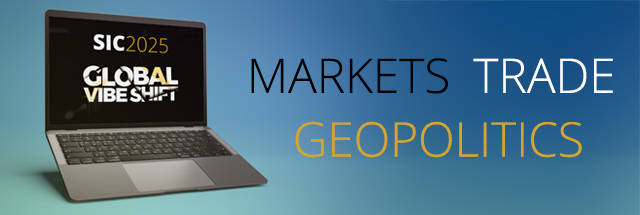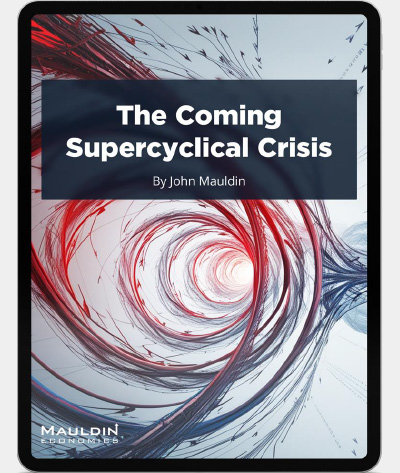
Tension in the Sandpile
-
 John Mauldin
John Mauldin
- |
- May 9, 2025
- |
- Comments
- |
- View PDF
I’ve been writing about tariffs for a couple of months now, focusing mostly on the macroeconomic harm and the costs they impose on small businesses. Today I want to consider something else: the new risks they are adding to the financial system alongside the old risks. We had a small taste of it when markets convulsed in early April. That episode passed, but I don’t think the risk is gone. Different and potentially worse may be coming, as the disruptions compound.
Longtime readers know my sandpile story. Imagine the pile of sand at the bottom of an hourglass. The pile grows as each new grain lands on top. The cone shape looks stable, but it’s not. Invisible fingers of connected instability are forming, and at some point, the pile will collapse, triggered by something falling on those fingers of instability.
The longer you go without a small or medium-size collapse, the larger the fingers of instability grow and ultimately the larger the sandpile collapse will be. You don’t know when it will happen, nor can you predict which grain of sand will trigger it. But it’s coming. Months—years—decades? As Minsky taught, stability breeds instability.
Global financial markets are a similarly complex system. We don’t fully understand the vast web of connections inside it. But we know the sandpile collapses every so often and it’s never fun. Our efforts to prevent these collapses simply let the pile grow larger, making the inevitable breakdowns even more damaging. There’s no way around this. All we can do is prepare for it.
One good way to prepare is to join my virtual Strategic Investment Conference.
I have the extraordinary privilege of hearing almost every faculty member before the conference in our preparation calls. Among other things, we go over their content. I get to ask questions. It is a period of intense learning for me. I have been doing this for 21 years now. There have only been two other years with the kind of intensity, passion, and uncertainty I’ve heard this time. Like all of us, the faculty are looking for the way forward. These are the experts in a wide variety of fields that you want to hear. Some are quite bullish for the long run and are preparing for what they believe will be significant upside in the next few years. Others are focused on the next 3 to 6 months. None are sanguine in the short term. But on balance, I see optimism on the way forward. It’s just not the way we’ve been walking in the past.
Howard Marks just stands out. As do Lacy and Danielle. Liz Ann Sonders and Karen Harris. Felix surprised me. It confirmed my recent belief that the Muddle Through Economy is morphing into what will become the Stumble Through Economy. The emphasis is on the word through.
There has been no despair or doom in the sessions, just a recognition that the path of getting through will be different now. Things are accelerating in so many arenas, especially on the tech front. And now the trade front. For us to expect anything other than accelerating economic change during these times would be rather naïve.
I think this is the best faculty we have ever had, especially considering the times we are in. The conference starts this Monday, May 12, and goes every other day for five days. You can watch it live, watch it later at your leisure, and of course read the transcripts which we try to post quickly. We are really emphasizing the Q&A part this year, and you don’t want to miss the final panel. Click here and join what is a large and growing group of my readers as we ready ourselves for the future.
Impossible Things
I have tried in these letters to explain how trade deficits work in a way anyone can understand. It’s actually quite difficult, mainly because a proper description requires more space than I have. My friend Lyn Alden’s latest newsletter is the best layman’s explanation I’ve seen. It is about 20 pages, and I highly recommend you read it—even if you think you already know how it all works. I promise you’ll learn something.
Lyn covers something important to our topic today: the huge amount (around $18 trillion) of dollar-denominated debt that exists outside the US. Foreigners and foreign entities also own about $61 trillion in US assets. These occasionally interact in problematic ways. I’ll quote Lyn’s explanation.
“Usually, the rest of the world services its debts by collecting trade surpluses and trading those dollars around. However, whenever the music starts to stop for one reason or another, dollars outside of the United States can become in short supply, at least relative to the gargantuan amount of dollar-denominated liabilities that exist. Since there are so few actual dollars relative to dollar liabilities, the system only works when dollars flow around with pretty high velocity to wherever they’re needed. When shortages and slowdowns happen, defaults start to occur, and well-capitalized entities can sell American assets to get dollars to service their dollar-denominated debts.
“An example of this occurred in March 2020 during the worst part of the pandemic lockdown crisis. An acute dollar shortage emerged as global trade dried up, and so foreign entities began selling Treasuries. Parts of the Treasury market went acutely illiquid, i.e., literally broke. US Treasuries are at the core of the US financial system, so that market breaking and becoming illiquid for an extended period of time would be catastrophic. In response, the Fed opened emergency swap lines with other countries and printed trillions of new base dollars to buy Treasuries and mortgage-backed securities to re-liquify the market…
“So, this whole system is massive and has no easy way to unwind quickly. Whenever it starts to even briefly unwind quickly, it triggers all sorts of emergency liquidity provisions to avoid breaking the US Treasury market and the associated interbank lending market. Over years and decades, it can unwind through a combination of money-printing and defaults, but that’s a very long process.”
Note also, the problems can occur between non-US parties with no direct American involvement. A Tanzanian borrower who sells US assets to raise dollars to repay their dollar-denominated debt to a Kuwaiti lender may not have anything against the US. It’s not personal. They just need dollars, and the fastest and most efficient way to get them is to sell some of their US bonds or stocks.
|
Everything is changing—faster than ever. Get insights from 30+ world-class experts at SIC 2025, May 12–21. |
This is why reducing the supply of offshore dollars—as happens when our trade deficit shrinks—tends to cause problems. Even if they don’t sell their US assets, bad things can happen if our former trading partners simply reduce their buying.
A small version of that happened last week when Taiwanese life insurers started unloading or trying to hedge their US bond holdings. They own those bonds because Taiwan, while much smaller than mainland China, runs a huge trade deficit with the US in percentage terms. The tariffs are forcing those insurers to adjust their portfolios.
Like what you're reading?
Get this free newsletter in your inbox every Saturday! Read our privacy policy here.
Ben Hunt thinks this is the beginning of a much larger long-term shift away from US assets. Here he talks about the early April Treasury volatility.
“A one-week 65 basis point increase in US long-term interest rates in the face of a dramatic global growth slowdown is an impossible thing. Impossible, that is, if global capital believes that the United States is good for its debts. Impossible, that is, if global capital believes that US debt obligations provide the risk-free rate for the world.
“But it wasn’t impossible. It happened. The US Treasury market—the touchstone of every loan in the world, every insurance policy in the world, every equity valuation in the world—broke last month, and it broke because the full faith and credit of the United States came into question.
“The break was temporary. After the initial Treasury crash on Monday, April 7, and Tuesday, April 8, the Trump administration rushed to say, ‘Haha! Just kidding about those reciprocal tariffs on everyone!’ and folded a lot of its cards on Wednesday, April 9. It folded still more of its cards the following week after a resurgent Treasury crash that Friday, April 11.
“Why did the administration fold most of its tariff cards? Because another one-week 65 basis point increase in US long-term interest rates would break the world. Seriously, everything would break. Every insurer would be in regulatory forbearance and would need to raise capital, and so would most banks. The dollar would crash. Equity markets would crash. Lending and credit would come to a screeching halt. The Fed would be forced to engage in what’s called ‘yield curve control’ where they would flat-out buy (and effectively force big US banks to buy) these 10-year and 30-year Treasuries in order to keep their value propped up and their interest rates tamped down. Would that work? Probably. For a while. Maybe.”
It is still not clear who was selling in that week or two. It wasn’t China, as some suspected (at least in size). More likely it was multiple liquidity-seeking entities rather than one big source. Some may have been American investors, too. Treasury yields subsequently recovered.
Much now depends on how the tariff situation develops over the next few months. But I think Ben is probably right that the move isn’t over. And if too much happens too quickly, there’s real risk of a sandpile collapse here.
No Dollars Needed
Lately I see a lot of worry about the greenback losing its reserve currency status. That could certainly happen, and indeed it probably will happen eventually. I don’t think it is imminent. But it’s also not impossible.
|
Charles Gave wrote a fascinating note last month on what a non-dollar trading system would look like. He described it using trade between China and Indonesia as an example.
“In any bilateral trading relationship, two key steps are needed to shift trade away from the US dollar.
- The two central banks must sign a swap agreement. So, in this case, the People’s Bank of China and Bank Indonesia agree on a bilateral swap line, say, for the equivalent of US$50bn, valid for the next five years.
- In each country, the authorities authorize a number of banks to access foreign currency liquidity via the swap line. So for example, Bank Indonesia accredits Bank Mandiri, Bank Central Asia, and a handful of others as officially approved banks for conducting renminbi business, while the PBoC designates Bank of China and a few of its peers to deal in rupiah.
“Now, imagine that BYD wants to sell electric cars in Indonesia. In Indonesia, local auto dealers borrow in rupiah from their customary banks to pay for the imports. These banks then go to an accredited intermediary to get renminbi, which are paid to BYD. The BYD dealers now sell the cars to their Indonesian customers and repay their borrowings in rupiah.
“Now assume that an electric power producer in Southern China buys coal in Indonesia for a similar amount at roughly the same time.
“The two transactions would cancel each other and would leave the US$50bn swap line unutilized. The only thing that has actually been used is the guarantee given by each central bank to provide currency liquidity to the other country’s banking system…
“At this point, the astute reader will have realized that trade between the two countries can explode without any requirement at all for US dollars. All that is needed is a bilateral agreement between the two central banks.
“In this world, there is no need for a global currency. Instead, each country has credit lines in the currencies of its neighbors. In short, the centralized system based on the world currency is replaced by a decentralized system based on a series of bilateral agreements between central banks.
“And these bilateral agreements are rapidly proliferating. The PBoC has around 40, including with Hong Kong, South Korea, Indonesia, Malaysia, Thailand, Singapore, Russia, Argentina, Mauritius, and Saudi Arabia.”
Could this really happen? Absolutely. The door will open when those swap agreements become more cost-effective than the current centralized dollar-based system. We’ve had the best mousetrap for a long time. Once a better one appears, foreigners will use it. And they won’t need to hold as many dollars as they do now.
These systems are currently quite small relative to the overall trading system. But global trade is not going to dry up because trade is simply the life blood of so many small economies. And businesses will do whatever it takes to stay in operation even if they have to adapt. That’s what a free market does. But wait, you say, many of those economies aren’t “free markets.” True, but they can still decide which currency to use.
We’ll all adapt if the transition happens gradually, which I think is likely. And new technologies will enable that transition. If something makes it happen quickly because supply chains and trade becomes difficult or noneconomic? The sandpile could easily become a sandstorm.
Potential Triggers
The sandpile has a variety of other instabilities, any of which could trigger a disorderly collapse—with or without tariffs and trade disputes.
US commercial real estate is one potential problem. The office market is in a particularly difficult position. The post-COVID shift to work-from-home models means businesses no longer need as much space as they used to. As leases expire, companies are moving to smaller quarters in newer buildings, leaving high vacancies in older properties. Worse, some of those older properties are financed with ZIRP-era low-rate loans that are rapidly expiring. Replacing them with new loans at today’s higher rates may bankrupt some owners. The result will likely be a bunch of fire-sale transactions. Wolf Richter recently reported on a 60-year-old San Francisco building that had been bought in 2016 for $141 million. It sold last month for only $44 million, an almost 70% loss.
That kind of discount seems to be the going rate for older properties. On one hand, that’s good news. It means the market isn’t completely frozen. But it’s exceedingly bad news if you are an overleveraged real estate investor. And it’s an even bigger problem for lenders, many of which are in the shadow banking system, with collateral marked to unrealistically high prices. This is how systemic problems start.
Note that the shadow banking system is now larger than the commercial banking system, is unregulated, and we have literally no idea of the risk involved. There are many solid, large, private credit funds that are well-run and transparent to their investors. I am a fan of them. But there are also some with liquidity mismatches. As Warren Buffett says, we will find out who is swimming naked when the tide goes out.
State and local government debt is another potential flash point. Many have been borrowing to sustain their woefully underfunded pension plans. That was always a band-aid solution and higher borrowing costs are making it less feasible. Lower stock and bond prices will aggravate the situation even further. Just last week, S&P lowered its bond rating for the City of Los Angeles. (The LA mayor’s proposed budget includes laying off about 1,650 workers, so this will show up in consumer spending, too.)
Another issue: Insurance costs are rising in disaster-prone areas like California and Florida. This reduces the tax base, which in many cases depends on local property values. Falling tax revenue, rising pension expenses, and higher interest rates are a toxic mix that could easily infect the municipal bond market.
If that happens, the calls for a federal bailout will be deafening, but Washington isn’t in especially good shape, either. The president’s FY 2026 budget proposal made no net cuts to discretionary spending (new defense spending offsets other reductions) while House Republicans are divided on issues like the SALT deduction and Medicaid cuts. I’m sure they’ll work out something but the kind of serious fiscal reforms we hoped to see are looking less likely. FY 2025 deficits will still approach $2 trillion. Sigh. There needs to be more significant cuts if we are going to avoid that same large number in 2026,
All that means the federal debt will keep growing, which means interest expenses will keep rising, which will put upward pressure on Treasury interest rates. If the trade situation makes foreigners less able or willing to help finance our debt, we are going to have problems.
Like what you're reading?
Get this free newsletter in your inbox every Saturday! Read our privacy policy here.
I didn’t even mention war and geopolitical concerns as much of the developed world becomes more responsible for its own defense, the real potential for the world to devolve into two major trading blocs over time, and so much more.
All these concerns, especially the federal debt, are huge fingers of instability and some of the economic turmoil we are experiencing has the potential to combine them.
On the plus side, businesses will keep expanding as they have done for so many decades. New technologies are improving our lives daily, as are health and medical breakthroughs everywhere. Production of critical supplies moving back to the US or friendly locales helps, too.
The trade deal with the UK, even though it was low-hanging fruit, is encouraging. I was in DC where I heard from more than one insider that Japan is simply saying, “Just tell us what the deal is.” I know for a fact that is happening in countries all over the world. It’s just complex trying to do it all at once.
I have been predicting a crisis at the end of this decade for several years. We don’t know how or when the sandpile will collapse. Something none of us currently imagine could be the trigger. But the pile can’t grow indefinitely. You need a strategy to get through this time, so I hope you’ll join me at SIC as we all figure it out together.
SIC, the Fed, and Dallas
I was in Washington, DC, this week for a private economic symposium governed by the Chatham House Rule. The speakers were major market and political insiders, and the attendees made me wonder why I was allowed in the room. It’s good to have friends. I can say that I heard Kevin Warsh interviewed (no recordings or transcripts) and he was very candid. Let me just say that I am now a huge fan and I dearly hope he is the next Fed chair.
The 3+-hour dinner that night with 10 people selected by my host was perhaps the most intense and educational table of my life. And that is saying something as I have been to hundreds of private dinners. I learned so much and wish I could experience something like that more often. It will take me weeks to absorb the content, but it will show up in future letters.
I will be in Dallas at the end of the month as we open our new longevity clinic there. Details will follow, but I have to hit the send button. Have a great week and truly consider joining the SIC conversation. And don’t forget to follow me on X where I will try to post during the week.
|
Your trying to absorb so much overwhelming information analyst,

John Mauldin
P.S. If you like my letters, you'll love reading Over My Shoulder with serious economic analysis from my global network, at a surprisingly affordable price. Click here to learn more.
Put Mauldin Economics to work in your portfolio. Your financial journey is unique, and so are your needs. That's why we suggest the following options to suit your preferences:
-
John’s curated thoughts: John Mauldin and editor Patrick Watson share the best research notes and reports of the week, along with a summary of key takeaways. In a world awash with information, John and Patrick help you find the most important insights of the week, from our network of economists and analysts. Read by over 7,500 members. See the full details here.
-
Income investing: Grow your income portfolio with our dividend investing research service, Yield Shark. Dividend analyst Kelly Green guides readers to income investments with clear suggestions and a portfolio of steady dividend payers. Click here to learn more about Yield Shark.
-
Invest in longevity: Transformative Age delivers proven ways to extend your healthy lifespan, and helps you invest in the world’s most cutting-edge health and biotech companies. See more here.
-
Macro investing: Our flagship investment research service is led by Mauldin Economics partner Ed D’Agostino. His thematic approach to investing gives you a portfolio that will benefit from the economy’s most exciting trends—before they are well known. Go here to learn more about Macro Advantage.
Read important disclosures here.
YOUR USE OF THESE MATERIALS IS SUBJECT TO THE TERMS OF THESE DISCLOSURES.
Tags
Did someone forward this article to you?
Click here to get Thoughts from the Frontline in your inbox every Saturday.

 John Mauldin
John Mauldin

